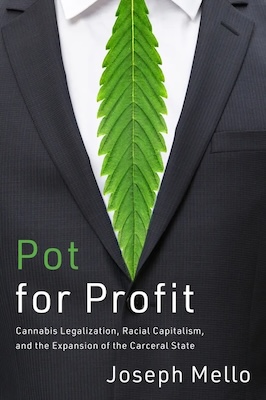
Pot for Profit book cover. Courtesy of Stanford University Press
Cannabis has undoubtedly experienced a cultural revolution since states began instituting recreational legalization over a decade ago. Across nearly half the U.S., it’s been recast as a socially acceptable (and lucrative) commodity. This has prompted corporate interests to invest capital into this still-developing “green rush.”
After almost a century as an illicit market used by those at the margins of society—the shift in policy and social perspective would appear to be a welcome development. Yet, as Joseph Mello, political science professor at DePaul University, deftly illustrates in his book Pot for Profit, legalization and economic prosperity has consequences.
Legalization has corporatized cannabis. Multi-state operators have displaced medical, underground, and small independent distributors. These operators orient legislative changes in their favor and eliminate the possibility of others—with less access to capital—to participate in the legal industry.
Not only does corporatization have a monetary impact on the cannabis industry, but it also changes its cultural landscape. Mello laments the loss of more progressive impulses of cannabis culture in favor of a market-friendly approach that is more approachable for the average consumer.
The Corporate-Pot Legislative Apparatus
Mello explains that grassroots efforts can sometimes efficiently promote and enact ballot measures to legalize cannabis. However, once it is legal, “[t]hose who wish to participate in the legal cannabis space must acquire the proper licenses, pay the required fees, and comply with a dizzying array of rules and regulations.”
Additionally, multi-billion-dollar companies such as Curaleaf and Truleaf have, “access to vast economic and legal resources, and they use this power to influence the regulatory rules that govern the cannabis industry.”
Not only do corporate multi-state companies hold a disproportionate share of the cannabis retail and grow market, but these corporations also indirectly determine the state laws that regulate these industries.
After using their resources to enter the market, multi-state companies employ expensive lobbyists to direct regulations in their interests. Crucially, their interests often conflict with those of smaller cannabis operators.
For instance, residency requirements to obtain a license to sell or grow cannabis is advantageous to local cannabis business owners since it prevents “out-of-state competition.” Yet, Mello writes that these restrictions “have been fiercely opposed by corporate cannabis interests.”
And, since multi-state operators can lobby against these regulations (intended to protect smaller cannabis business owners), almost no states, aside from Washington, have “robust” residency laws.
Pot for Profit also illustrates how corporate interests inform the state amendments and ballot initiatives that lead to legalization. Specifically, the language on the state measures already pre-favors corporate operators. Many states, for instance, have left out language permitting home grows due to these corporate influences.
Those Left Behind: Race and Legalization
Pot for Profit also shows how corporatization contributes to racial disparities in the cannabis industry. These disparities are consistent with the pre-legalization punitive impacts of cannabis laws, which tended to incarcerate more minorities. Mello finds that the U.S. cannabis industry is “dominated by white business owners, most of whom had little relationship to cannabis prior to legalization.”
Simply, those most affected by cannabis prohibition are least likely to be involved in the industry post-legalization.
Although Mello recognizes that the cannabis industry is disproportionately white, many of his insights and solutions are simplistic and two-dimensional. He conceives of cannabis legalization as a form of “reparations” to “repair” past injustices. However, it is unclear how legalization could conceivably do this. Mello also makes an argument on the loss of income for illicit cannabis sellers. For instance, he claims that “whole communities” depend on illegal cannabis sales.
This may be true in some instances, such as rural parts of Northern California. But it is a necessary consequence of legalization (since it must be regulated). It is also infinitely preferable for there to be fewer cannabis arrests overall (for things such as possession). The point of regulation is not, as Mello claims, an unjust deployment of power. It is, instead, to ensure safety for public consumption (the same reason there are building regulations, for instance). However, as Mello makes clear, regulation does leave many behind.
Some cannabis reforms that Mello mentions, such as pardoning past cannabis offenses and making the cannabis licensure process less financially prohibitive, could certainly rectify past injustices. He also suggests that more people of color regulate cannabis. Yet, these kinds of gestures prove to be symbolic. Regardless of the regulator’s race, cannabis will be regulated. And unless those regulations protect smaller operators, the cannabis industry will consist of the same racial demographics.
In short, despite analyzing this dominance of the market in racialized terms, many of Mello’s criticisms lead back to class. The primary barriers to entry are financial. In some states, it can cost well over $100,000 to apply for a license.
Social and Cultural Changes: “From Tie Dye to Suit and Tie”
The most incisive aspect of Mello’s book is his analysis of the cannabis movement’s culture and shifting perspectives on the plant. Mello relies on 40 interviews throughout the book with anonymous cannabis activists, business owners, growers, and underground sellers. Interviewees commonly expressed a similar sentiment toward legalization, that it changed cannabis. As one interviewee puts it, cannabis has gone from “tie dye to suit and tie.”
Many felt that to legalize cannabis, they needed to embrace a more corporate, economic-oriented argument. Rather than an emphasis on bodily autonomy, the legalization conversation oftentimes centered on increased tax revenues, jobs, and other economic concerns.
This informed not only the legalization language itself but also the culture of legalization. Some of the cultural changes are superficial, like the clothing worn by supporters. But other changes are more substantive, such as the way that many generally perceive cannabis.
While others previously viewed cannabis in its spiritual, medicinal, or purely recreational dimensions—after legalization, many only value it for its ability to make money. Mello demonstrates that the suit-and-tie takeover of cannabis is the most pervasive post-legalization change: Cannabis is no longer a plant—it is now a product.
Today, because of corporatization, the “pothead” does not exist, only habitually returning customers.



Leave a Reply